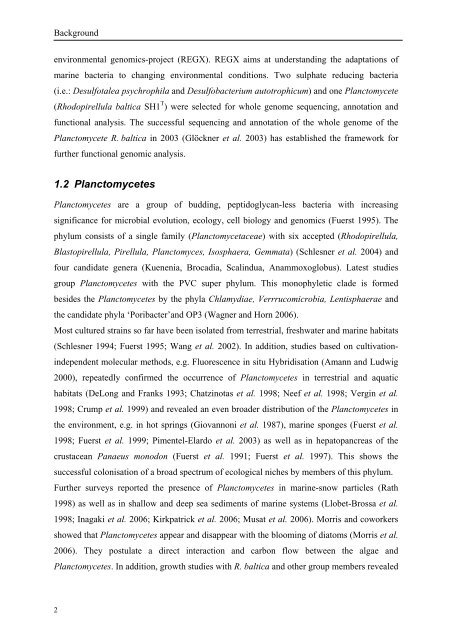a Whole Genome Array Approach - Jacobs University
a Whole Genome Array Approach - Jacobs University
a Whole Genome Array Approach - Jacobs University
Create successful ePaper yourself
Turn your PDF publications into a flip-book with our unique Google optimized e-Paper software.
Background<br />
environmental genomics-project (REGX). REGX aims at understanding the adaptations of<br />
marine bacteria to changing environmental conditions. Two sulphate reducing bacteria<br />
(i.e.: Desulfotalea psychrophila and Desulfobacterium autotrophicum) and one Planctomycete<br />
(Rhodopirellula baltica SH1 T ) were selected for whole genome sequencing, annotation and<br />
functional analysis. The successful sequencing and annotation of the whole genome of the<br />
Planctomycete R. baltica in 2003 (Glöckner et al. 2003) has established the framework for<br />
further functional genomic analysis.<br />
1.2 Planctomycetes<br />
Planctomycetes are a group of budding, peptidoglycan-less bacteria with increasing<br />
significance for microbial evolution, ecology, cell biology and genomics (Fuerst 1995). The<br />
phylum consists of a single family (Planctomycetaceae) with six accepted (Rhodopirellula,<br />
Blastopirellula, Pirellula, Planctomyces, Isosphaera, Gemmata) (Schlesner et al. 2004) and<br />
four candidate genera (Kuenenia, Brocadia, Scalindua, Anammoxoglobus). Latest studies<br />
group Planctomycetes with the PVC super phylum. This monophyletic clade is formed<br />
besides the Planctomycetes by the phyla Chlamydiae, Verrrucomicrobia, Lentisphaerae and<br />
the candidate phyla ‘Poribacter’and OP3 (Wagner and Horn 2006).<br />
Most cultured strains so far have been isolated from terrestrial, freshwater and marine habitats<br />
(Schlesner 1994; Fuerst 1995; Wang et al. 2002). In addition, studies based on cultivationindependent<br />
molecular methods, e.g. Fluorescence in situ Hybridisation (Amann and Ludwig<br />
2000), repeatedly confirmed the occurrence of Planctomycetes in terrestrial and aquatic<br />
habitats (DeLong and Franks 1993; Chatzinotas et al. 1998; Neef et al. 1998; Vergin et al.<br />
1998; Crump et al. 1999) and revealed an even broader distribution of the Planctomycetes in<br />
the environment, e.g. in hot springs (Giovannoni et al. 1987), marine sponges (Fuerst et al.<br />
1998; Fuerst et al. 1999; Pimentel-Elardo et al. 2003) as well as in hepatopancreas of the<br />
crustacean Panaeus monodon (Fuerst et al. 1991; Fuerst et al. 1997). This shows the<br />
successful colonisation of a broad spectrum of ecological niches by members of this phylum.<br />
Further surveys reported the presence of Planctomycetes in marine-snow particles (Rath<br />
1998) as well as in shallow and deep sea sediments of marine systems (Llobet-Brossa et al.<br />
1998; Inagaki et al. 2006; Kirkpatrick et al. 2006; Musat et al. 2006). Morris and coworkers<br />
showed that Planctomycetes appear and disappear with the blooming of diatoms (Morris et al.<br />
2006). They postulate a direct interaction and carbon flow between the algae and<br />
Planctomycetes. In addition, growth studies with R. baltica and other group members revealed<br />
2

















